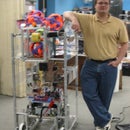Introduction: Toolbox Insert
Don't be a tool... protect your tools.
The following is a first round prototype of a tool box insert used to protect a hand held meter from damage in transport. The prototype took about about an hour to scrounge up materials and fabricate.
The idea is that I have a number of tools that had packaging that was not intended for ongoing usage. Rather than leaving them around out of any box, or bundled with other tools, I could create a box insert
The Benefits include:
- keep tool from getting damaged prematurely...
- make easily identifiable & stackable.
- Promote kiting to enable specific task.
Tools:
- retractable utility knife / Scissors
- cutting mat
- pen
Materials:
- toolbox / generic enclosure
- Scrap Cardboard
- Shoe lace
- Rag / sock
- Items to be stored
- meter
- Spare Battery
Please note: The project is specifically using materials selected from items that might generally be discarded.
Waste not want not.
Step 1: Create Insert Panels
The first part was to create panels to be stacked in the enclosure. Since this was a prototype, I decided to use only mechanical retention, rather then glue or tape. Additionally, the panels were made into simple rectangles. Down the road there is certainly the potential for more efficient cutout geometries to keep waste down further. I selected a corrugated box to reduce the number of needed panels. The corrugation also helped keep cuts relatively straight
Using a lid panel I scored along a corrugation channel, to get the initial panel width, and then used this as a measuring stick for subsequent panels. I had not fully decided if I would do horizontal or vertical panels, but fitting the first one was snug, so I realized that vertical panels could be fit and held in place quicker without the need for binders such as glue or tape. The first panel fit in the lid notch, so the panels were cut too tall to start. To close the lid, The panels were cut down a bit.
Once all the panels fit, I used the meter to trace a rough outline on a panel. Then I cut out the first panel and used it as a transfer template. This is when I started to think about more efficient geometries. I transfered and cut out as many panels as the tool would need to fit comfortably.
Since the panels were a bit rough, I added a worn out sock as a sleeve to keep the meter from getting scratched up. As a bonus it made the fit more snug.
Step 2: Spare Battery
The more observant will have noted the straps capping off the uncut portions of the panels. They a suspiciously the size of panel cut downs. Originally, some panels would have been modified to hold a battery. However, as a prototype I wanted to try a few different things. So I poked a couple holes in a a strap and used a few wraps of an old shoelace to hold down a spare battery.
Step 3: Conclusion
So some observations:
- Mechanical retention was sufficient for this case to prevent rattling
- More efficient geometries will likely reduce waste further.
- layout of panel cuts
- orientation items to be stored
- Originally considered mistake, not keeping cutouts close to narrower handle part made it easier to grab.
- Forming the padding to the enclosure may be quicker to access the tool then using a sleeve.
- Thinking about the tool in the context of a kit to perform a task helps with preparedness. For example since this is a meter, it may make sense to add a way to write down measurements.
- With this smaller test done, I have some other things to explore:
- Inspection scope was the original inspiration, but I wanted to start out with something that didn't need so much material.
- Laser level
- Hand held tools with flimsy or non-existent packaging
- Peripherals that could benefit from built in cable management.

Participated in the
Trash to Treasure













